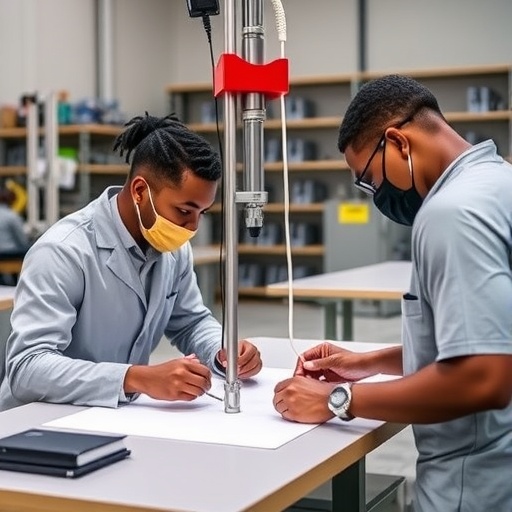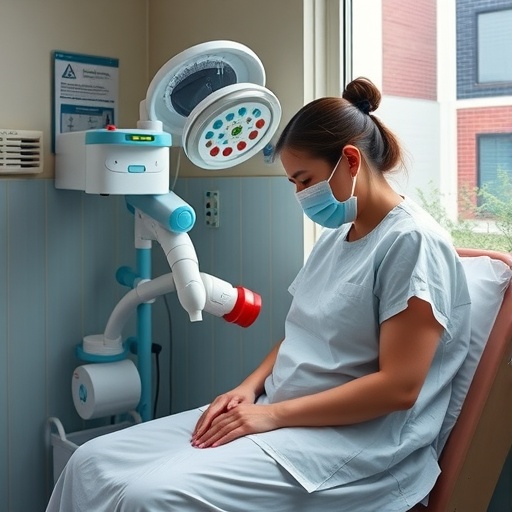In an innovative approach to biomedical engineering education, researchers have developed a new methodology aimed at enhancing the understanding of consensus standards within the discipline. This initiative, unveiled by a dedicated research team, revolves around the creation of a round-robin module that integrates practical testing using a custom tensile testing device. By focusing on the application of fundamental scientific principles through real-world experiments, this program promises to sharpen students’ skills and enhance their educational experience in the field of biomedical engineering.
The integration of a round-robin module signifies a significant shift in educational curricula. Traditional learning often relies heavily on theoretical frameworks, which may not adequately prepare students for the challenges they will face in professional environments. This novel module addresses that gap by fostering an experiential learning environment. The hands-on engagement not only reinforces theoretical concepts but also instills a deeper understanding of the applicability of these concepts in real-world scenarios.
The custom tensile testing device serves as the centerpiece of this educational framework. Designed with precision and ease of use in mind, this device allows students to conduct tensile tests on various materials, gaining insight into the mechanical properties that are critical for biomedical applications. By working directly with this technology, students can better appreciate the complex interactions between materials and biological systems, paving the way for innovative developments in medical devices and implants.
One of the objectives of the round-robin approach is to standardize the methodology employed in testing and analysis. In the past, variations in testing protocols could lead to inconsistent results, complicating comparisons and the generalizability of findings. By establishing a consensus on testing standards, this project aims to promote uniformity in practices across different educational institutions. As a result, students and researchers will be equipped with a reliable framework that enhances collaboration and discourse within the biomedical engineering community.
The research emphasizes the importance of consensus standards in the biomedical engineering landscape. These standards not only guide design and testing practices but also ensure that products meet safety and efficacy benchmarks before they reach the marketplace. Inculcating these standards into the educational curriculum fosters a sense of responsibility among students, preparing them to uphold industry best practices in their future careers.
Feedback from early trials of the round-robin module has been overwhelmingly positive. Students reported enhanced engagement and a greater appreciation for the complexities of material science as they applied their knowledge in practical settings. The transition from theoretical concepts to hands-on practice has proved to be a powerful motivator, prompting students to delve deeper into their studies. This experiential learning approach has resonated with learners, making the material more relatable and stimulating critical thinking.
Moreover, the collaborative nature of the project encourages teamwork among students. In the round-robin setup, individuals are often required to work together to solve problems and analyze data. This collaboration simulates the interdisciplinary teamwork that is commonplace in biomedical engineering projects. By honing their teamwork and communication skills through this approach, students are better prepared for their future roles in the workforce.
An additional benefit of utilizing the custom tensile testing device within this educational module is the opportunity for students to become familiar with the types of equipment they will encounter in their professional lives. Exposure to state-of-the-art technology opens avenues for students to explore innovative design possibilities and assess material performance in a variety of healthcare contexts. These experiences not only enhance their technical acumen but also cultivate a mindset geared towards innovative problem-solving.
The current iteration of the round-robin module will continuously evolve as feedback from students and educators is collected and analyzed. Such iterative refinements ensure that the educational program remains relevant and effective, aligned with the latest advancements in biomedical engineering. Future phases of the project may also explore broader applications of the devised approach in other fields, potentially unlocking new areas of exploration and learning.
As this project progresses, it is anticipated that the implications will extend beyond the classroom. By shaping capable engineers who are well-versed in consensus standards and practical methodologies, the initiative hopes to contribute to the overall advancement of biomedical engineering as a profession. Well-prepared engineers are essential for driving forward innovations that can improve patient outcomes and healthcare solutions globally.
The endeavor demonstrates a robust commitment to elevating the quality of biomedical engineering education. Through the development of a round-robin testing module using a custom tensile testing device, educational institutions can offer students a richer learning experience that merges theory and practice. Ultimately, this innovative framework has the potential to produce graduates who are not only knowledgeable but also adept at navigating the complexities of the biomedical field.
This work sets a precedent for continued investment in hands-on learning within engineering education. It encapsulates a broader trend towards experiential learning, where theory is intertwined with practice to foster deeper understanding and retention of knowledge. Institutions looking to refine their educational offerings in STEM should take heed of such innovative approaches that enhance student engagement and career readiness.
As the education landscape evolves, so too must the methods we employ to prepare future engineers. The round-robin module represents a significant stride toward achieving that goal. With its emphasis on consensus standards, practical experimentation, and collaborative learning, the project positions itself as a pioneering approach that many might follow in the pursuit of excellence in education.
In conclusion, the round-robin module developed by Nunnally and colleagues is not solely a pedagogical tool; it is a comprehensive initiative aimed at reforming biomedical engineering education. The integration of consensus standards into a hands-on curriculum lays down a solid foundation for future engineers, equipping them with the skills to innovate and excel in a rapidly evolving field. As this educational endeavor continues to flourish, its impact on both students and the biomedical engineering profession is bound to be profound and long-lasting.
Subject of Research: Development of a round-robin module for biomedical engineering education integration of consensus standards
Article Title: Developing a Round-Robin Module For The Integration Of Consensus Standards In a BME Course Using a Custom Tensile Testing Device
Article References:
Nunnally, C., Defante, A.P., Browne, M.G. et al. Developing a Round-Robin Module For The Integration Of Consensus Standards In a BME Course Using a Custom Tensile Testing Device.
Biomed Eng Education (2025). https://doi.org/10.1007/s43683-025-00200-x
Image Credits: AI Generated
DOI:
Keywords: Biomedical engineering, consensus standards, round-robin testing, educational innovation, tensile testing device
Tags: Biomedical engineering educationconsensus standards in engineeringcustom tensile testing deviceenhancing student skills in engineeringexperiential learning in engineeringhands-on biomedical engineeringinnovative teaching methods in engineeringmechanical properties of biomedical materialspractical applications of engineering principlesreal-world engineering challengesround-robin educational moduletensile testing methodology





